Effect of Crumb Rubber, Fly Ash, and Nanosilica on the Properties of Self-Compacting Concrete Using Response Surface Methodology
Abstract
:1. Introduction
2. Materials and Methods
2.1. Materials Compositions and Properties
2.2. RSM Mix Design and Materials Proportioning
2.3. Mixing and Testing
2.3.1. Mixing
2.3.2. Workability Tests
- Slump flow test: This was performed by filling a slump cone placed at the center of two concentric circles marked on a nonabsorbent platform. The slump cone was then removed, and the time taken for the mixture to reach a 500 mm spread circle was recorded as T500 flow time. The maximum diameter of flow spread was also recorded in two directions at 90° as slump flow (dmax).
- L-box test: This is done to test the concrete’s ability to pass through obstacles without the constituents separating. The passing ability is calculated by dividing the concrete height at the end of the horizontal segment by the height of the remaining concrete in the vertical section. The blocking ratio must not be less than 0.8, and it is calculated using the formula [44]:
- V-funnel test: This is used to test the viscosity and filling ability of the SCC mixture. The trap door at the bottom of the funnel is closed, and the fresh mix is filled into the funnel without tamping. Once the concrete mixture is level at the top of the funnel, the trap door is opened, and the time taken for the mixture to discharge is recorded as the flow time.
2.3.3. Mechanical Properties Tests
- Compressive strength: For each of the 20 mixes developed, three 100-mm cube samples were cast and tested at 7, 14, and 28 days of curing based on the requirements of BS 1881: Part 116:1983. The cubes were subjected to a gradually increasing axial load using the 300-kN universal testing machine until failure. The average of the three results was reported as the compressive strength of the mix at that particular curing day.
- Direct tensile strength test: The tensile strength of the concrete mixes was determined using a dog-bone specimen having a dimension of 420 × 120 × 30 mm3, based on the provisions of the Japan Society of Civil Engineers (JSCE). Using a universal testing machine (UTM), a direct tensile load was applied through the axis of the sample at a rate of 0.15 mm/ minute until failure. The average of three results was reported as the tensile strength of the mix at 28 days accordingly.
- Flexural strength: Using three 500 × 100 × 25 mm3 beam samples at 28 days of curing, the flexural strength of the mixes was determined using the center point testing method based on the ASTM C78/C78M requirements at a loading rate of 5 mm/ min. The average of three results was reported as the flexural strength of the mix at 28 days accordingly.
3. Results
3.1. Workability Properties
3.2. Mechanical Properties
3.2.1. Compressive Strength
3.2.2. Flexural Strength
3.2.3. Tensile Strength
4. FESEM Analysis
5. RSM Modeling and Optimization
5.1. Response Surface Models Development and ANOVA
5.2. Optimization
6. Conclusions
- In the fresh state, the RSCC workability properties measured through T500, slump flow, L-box, and V-funnel tests increased with an increase in the FA replacement due to its smooth spherical particles, while the opposite effect was observed with CR replacement and NS addition. Due to the rough surface texture and low density of the rubber particles, CR caused the most significant loss in all the workability parameters. The reduction in the workability with the NS addition is ascribed to the large surface area of the particles, which absorbed much of the mixing water, reducing the mix’s fluidity.
- Increases in NS and modest levels of FA boosted the concrete’s compressive, flexural, and tensile strengths, which was ascribed to the physicochemical effects of the NS and FA, resulting in a dense and compact microstructure. On the other hand, increases in the CR resulted in a considerable reduction in the concrete’s mechanical strengths, which was attributed to the CR’s low stiffness and poor bonding at the CR-cement interface. However, at all CR replacement levels, all mixes containing NS attained the compressive strength beyond the minimum specified by ACI318 for structural concrete due to its enhancement of the bonding between the CR and hardened cement paste at the ITZ. In addition, the brittleness of the concrete is reduced owing to the CR.
- A closer look at the interaction of the FA, NS, and CR through FESEM revealed a formation of more S-C-H gel and densification of the concrete microstructure due to the FA and NS. In addition, the densification of the ITZ between the CR and cement paste by the NS was observed. Similarly, the images revealed the propagation of microcracks around the CR due to the stress concentration.
- Response surface models for predicting the mechanical strengths were developed and validated using ANOVA. The models have R2 values of 99%, 87%, and 96% for CS, FS, and TS, respectively. An optimization produced 36.38%, 4.08%, and 1.0% for the optimum FA, CR, and NS replacement levels at a desirability value of 60%. Experimental validation demonstrated a strong correlation between predicted and experimental results, with a percentage error of less than 5% for all three responses analyzed.
- It is evident from the results that a rubberized self-compacting concrete with FA and NS can be produced to have good workability properties in the fresh state and appreciable mechanical strengths at the hardened state.
Author Contributions
Funding
Institutional Review Board Statement
Informed Consent Statement
Data Availability Statement
Conflicts of Interest
References
- CT-13; Concrete Terminology—An ACI Standard. ACI: Farmington Hills, MI, USA, 2017.
- Alaloul, W.S.; Musarat, M.A.; Haruna, S.; Law, K.; Tayeh, B.A.; Rafiq, W.; Ayub, S. Mechanical Properties of Silica Fume Modified High-Volume Fly Ash Rubberized Self-Compacting Concrete. Sustainbility 2021, 13, 5571. [Google Scholar] [CrossRef]
- Wanasinghe, D.; Aslani, F.; Dai, K. Effect of age and waste crumb rubber aggregate proportions on flexural characteristics of self-compacting rubberized concrete. Struct. Conc. 2021, 1–20. [Google Scholar] [CrossRef]
- Muhammad, A.; Thaniel, K.C. Suitability of Blending Rice Husk Ash and Calcined Clay for the Production of Self-Compacting Concrete: A Review. Materials 2021, 14, 6252. [Google Scholar] [CrossRef] [PubMed]
- Bignozzi, M.C.; Sandrolini, F. Tyre rubber waste recycling in self-compacting concrete. Cem. Conc. Res. 2006, 36, 735–739. [Google Scholar] [CrossRef]
- Cabrera, M.; Martinez-Echevarria, M.J.; Lopez-Alonso, M.; Agrela, F.; Rosales, J. Self-Compacting Recycled Concrete Using Biomass Bottom Ash. Materials 2021, 14, 6084. [Google Scholar] [CrossRef]
- Gamil, Y.; Nilimaa, J.; Emborg, M.; Cwirzen, A. Lateral Formwork Pressure for Self-Compacting Concrete—A Review of Prediction Models and Monitoring Technologies. Materials 2021, 14, 4767. [Google Scholar] [CrossRef]
- Shaji, R.; Ramkrishnan, R.; Sathyan, D. Strength characteristics of crumb rubber incorporated self-compacting concrete. Mater. Today Proc. 2021, 4, 4741–4745. [Google Scholar] [CrossRef]
- Gupta, N.; Siddique, R.; Belarbi, R. Sustainable and Greener Self-Compacting Concrete incorporating Industrial By-Products: A Review. J. Clean. Prod. 2021, 284, 124803. [Google Scholar] [CrossRef]
- Revilla-Cuesta, V.; Skaf, M.; Faleschini, F.; Manso, J.M.; Ortega-López, V. Self-compacting concrete manufactured with recycled concrete aggregate: An overview. J. Clean. Prod. 2020, 262, 121362. [Google Scholar] [CrossRef]
- Faraj, R.H.; Ali, H.F.H.; Sherwani, A.F.H.; Hassan, B.R.; Karim, H. Use of recycled plastic in self-compacting concrete: A comprehensive review on fresh and mechanical properties. J. Build. Eng. 2020, 30, 101283. [Google Scholar] [CrossRef]
- Ferrara, L.; Park, Y.-D.; Shah, S.P. A method for mix-design of fiber-reinforced self-compacting concrete. Cem. Concr. Res. 2007, 37, 957–971. [Google Scholar] [CrossRef]
- Murali, M.; Mohammed, B.; Abdulkadir, I.; Liew, M.; Alaloul, W. Utilization of Crumb Rubber and High-Volume Fly Ash in Concrete for Environmental Sustainability: RSM-Based Modeling and Optimization. Materials 2021, 14, 3322. [Google Scholar] [CrossRef]
- Thomas, B.S.; Gupta, R.C.; Panicker, V.J. Recycling of waste tire rubber as aggregate in concrete: Durability-related performance. J. Clean. Prod. 2016, 112, 504–513. [Google Scholar] [CrossRef]
- Lương, Q.-H.; Nguyễn, H.H.; Choi, J.-I.; Kim, H.-K.; Lee, B.Y. Effects of crumb rubber particles on mechanical properties and sustainability of ultra-high-ductile slag-based composites. Const. Build. Mater. 2020, 272, 121959. [Google Scholar] [CrossRef]
- Mohammed, B.S.; Khed, V.C.; Nuruddin, M.F. Rubbercrete mixture optimization using response surface methodology. J. Clean. Prod. 2018, 171, 1605–1621. [Google Scholar] [CrossRef]
- Mohammed, B.S.; Liew, M.S.; Alaloul, W.S.; Al-Fakih, A.; Ibrahim, W.; Adamu, M. Development of rubberized geopolymer interlocking bricks. Case Stud. Constr. Mater. 2018, 8, 401–408. [Google Scholar] [CrossRef]
- Abdulkadir, I.; Mohammed, B.S. RSM Study and Analysis on the 6 months Compressive Strength Development and Shrinkage Behavior of High Volume Fly Ash ECC (HVFA-ECC). Int. J. Adv. Res. Eng. Technol. 2020, 11, 965–980. [Google Scholar] [CrossRef]
- Mohammed, B.S.; Xian, L.W.; Haruna, S.; Liew, M.S.; Abdulkadir, I.; Zawawi, N.A.W.A. Deformation Properties of Rubberized Engineered Cementitious Composites Using Response Surface Methodology. Iran. J. Sci. Technol. Trans. Civ. Eng. 2020, 45, 729–740. [Google Scholar] [CrossRef]
- Loganathan, R.; Mohammed, B.S. Properties of Rubberized Engineered Cementitious Composites Containing Nano-Silica. Materials 2021, 14, 3765. [Google Scholar] [CrossRef]
- Yung, W.H.; Yung, L.C.; Hua, L.H. A study of the durability properties of waste tire rubber applied to self-compacting concrete. Const. Build. Mater. 2013, 41, 665–672. [Google Scholar] [CrossRef]
- Huang, B.; Cao, J.; Shu, X. Rubber-Modified Cementitious Substance and Method of Making the Same. U.S. Patent No. 7,985,786, 26 July 2011. [Google Scholar]
- Tortum, A.; Celik, C.; Aydin, A.C. Determination of the optimum conditions for tire rubber in asphalt concrete. Build. Env. 2005, 40, 1492–1504. [Google Scholar] [CrossRef]
- Nguyen, T.H.; Toumi, A.; Turatsinze, A. Mechanical properties of steel fiber reinforced and rubberized cement-based mortars. Mater. Des. 2010, 641–647. [Google Scholar] [CrossRef]
- Mohammed, B.S.; Azmi, N.J. Strength reduction factors for structural rubbercrete. Front. Struct. Civ. Eng. 2014, 8, 270–281. [Google Scholar] [CrossRef]
- Mohammed, B.; Azmi, N.J.; Abdullahi, M. Evaluation of rubbercrete based on ultrasonic pulse velocity and rebound hammer tests. Constr. Build. Mater. 2011, 25, 1388–1397. [Google Scholar] [CrossRef]
- Khed, V.C.; Mohammed, B.S.; Nuruddin, M.F. Effects of different crumb rubber sizes on the flowability and compressive strength of hybrid fibre reinforced ECC. In IOP Conference Series: Earth and Environmental Science; IOP Publishing: Bristol, UK, 2018. [Google Scholar] [CrossRef]
- Bušić, R.; Miličević, I.; Šipoš, T.K.; Strukar, K. Recycled Rubber as an Aggregate Replacement in Self-Compacting Concrete—Literature Overview. Materials 2018, 11, 1729. [Google Scholar] [CrossRef] [PubMed] [Green Version]
- Ameri, F.; Shoaei, P.; Musaeei, H.R.; Zareei, S.A.; Cheah, C.B. Partial replacement of copper slag with treated crumb rubber aggregates in alkali-activated slag mortar. Constr. Build. Mater. 2020, 256, 119468. [Google Scholar] [CrossRef]
- Youssf, O.; Hassanli, R.; Mills, J.E.; Skinner, W.; Ma, X.; Zhuge, Y.; Roychand, R.; Gravina, R. Influence of Mixing Procedures, Rubber Treatment, and Fibre Additives on Rubcrete Performance. J. Compos. Sci. 2019, 3, 41. [Google Scholar] [CrossRef] [Green Version]
- Lakusic, S. Properties of high strength concrete containing surface-modified crumb rubber. J. Croat. Ass. Civ. Eng. 2019, 71, 579–588. [Google Scholar] [CrossRef] [Green Version]
- Onuaguluchi, O. Effects of surface precoating and silica fume on crumb rubber-cement matrix interface and cement mortar properties. J. Clean. Prod. 2015, 104, 339–345. [Google Scholar] [CrossRef]
- Onuaguluchi, O.; Panesar, D.K. Hardened properties of concrete mixtures containing precoated crumb rubber and silica fume. J. Clean. Prod. 2014, 82, 125–131. [Google Scholar] [CrossRef]
- Najim, K.B.; Hall, M.R. Crumb rubber aggregate coatings/pretreatments and their effects on interfacial bonding, air entrapment and fracture toughness in self-compacting rubberised concrete (SCRC). Mater. Struct. 2013, 46, 2029–2043. [Google Scholar] [CrossRef]
- Li, G.; Wang, Z.; Leung, C.K.; Tang, S.; Pan, J.; Huang, W.; Chen, E. Properties of rubberized concrete modified by using silane coupling agent and carboxylated SBR. J. Clean. Prod. 2016, 112, 797–807. [Google Scholar] [CrossRef]
- Dong, Q.; Huang, B.; Shu, X. Rubber modified concrete improved by chemically active coating and silane coupling agent. Const. Build. Mater. 2013, 48, 116–123. [Google Scholar] [CrossRef]
- Abd-Elaal, E.-S.; Araby, S.; Mills, J.; Youssf, O.; Roychand, R.; Ma, X.; Zhuge, Y.; Gravina, R.J. Novel approach to improve crumb rubber concrete strength using thermal treatment. Constr. Build. Mater. 2019, 229, 116901. [Google Scholar] [CrossRef]
- AbdelAleem, B.H.; Hassan, A.A.A. Development of self-consolidating rubberized concrete incorporating silica fume. Const. Build. Mater. 2018, 161, 389–397. [Google Scholar] [CrossRef]
- Mousa, M.I. Effect of elevated temperature on the properties of silica fume and recycled rubber-filled high strength concretes (RHSC). HBRC J. 2017, 13, 1–7. [Google Scholar] [CrossRef] [Green Version]
- Gupta, T.; Chaudhary, S.; Sharma, R.K. Mechanical and durability properties of waste rubber fiber concrete with and without silica fume. J. Clean. Prod. 2016, 112, 702–711. [Google Scholar] [CrossRef]
- Mohammed, B.S.; Awang, A.B.; Wong, S.S.; Nhavene, C.P. Properties of nano silica modified rubbercrete. J. Clean. Prod. 2016, 119, 66–75. [Google Scholar] [CrossRef]
- Qing, Y.; Zenan, Z.; Deyu, K.; Rongshen, C. Influence of nano-SiO2 addition on properties of hardened cement paste as compared with silica fume. Constr. Build. Mater. 2007, 21, 539–545. [Google Scholar] [CrossRef]
- Shahrul, S.; Mohammed, B.S.; Wahab, M.M.A.; Liew, M.S. Mechanical Properties of Crumb Rubber Mortar Containing Nano-Silica Using Response Surface Methodology. Materials 2021, 14, 5496. [Google Scholar] [CrossRef]
- Rahim, N.I.; Mohammed, B.S.; Al-Fakih, A. Physical properties of rubberized self-consolidating concrete (R-SCC) incorporating nano-silica. AIP Conf. Proc. 2021, 2339, 020121. [Google Scholar] [CrossRef]
- Nandhini, K.; Ponmalar, V. Effect of Blending Micro and Nano Silica on the Mechanical and Durability Properties of Self-Compacting Concrete. Silicon 2021, 13, 687–695. [Google Scholar] [CrossRef]
- Fakhri, M.; Yousefian, F.; Amoosoltani, E.; Aliha, M.R.M.; Berto, F. Combined effects of recycled crumb rubber and silica fume on mechanical properties and mode I fracture toughness of self-compacting concrete. Fatigue Fract. Eng. Mater. Struct. 2021, 44, 2659–2673. [Google Scholar] [CrossRef]
- Nandhini, K.; Ponmalar, V. Investigation on nano-silica blended cementitious systems on the workability and durability performance of self-compacting concrete. Mater. Express 2020, 10, 10–20. [Google Scholar] [CrossRef]
- Bušić, R.; Benšić, M.; Miličević, I.; Strukar, K. Prediction Models for the Mechanical Properties of Self-Compacting Concrete with Recycled Rubber and Silica Fume. Materials 2020, 13, 1821. [Google Scholar] [CrossRef] [PubMed] [Green Version]
- Almohammad-Albakkar, M.; Behfarnia, K. Effects of the combined usage of micro and nano-silica on the drying shrinkage and compressive strength of the self-compacting concrete. J. Sustain. Cem. Mater. 2020, 10, 92–110. [Google Scholar] [CrossRef]
- Sasanipour, H.; Aslani, F.; Taherinezhad, J. Effect of silica fume on durability of self-compacting concrete made with waste recycled concrete aggregates. Constr. Build. Mater. 2019, 227, 116598. [Google Scholar] [CrossRef]
- Li, N.; Long, G.; Ma, C.; Fu, Q.; Zeng, X.; Ma, K.; Xie, Y.; Luo, B. Properties of self-compacting concrete (SCC) with recycled tire rubber aggregate: A comprehensive study. J. Clean. Prod. 2019, 236. [Google Scholar] [CrossRef]
- Güneyisi, E.; Atewi, Y.R.; Hasan, M.F. Fresh and rheological properties of glass fiber reinforced self-compacting concrete with nanosilica and fly ash blended. Const. Build. Mater. 2019, 211, 349–362. [Google Scholar] [CrossRef]
- ASTM C33-18; Standard Specification for Concrete Aggregates. ASTM International: West Conshohocken, PA, USA, 2018.
- EFNARC. Specification and Guidelines for Self-Compacting Concrete; EFNARC: Farnham, UK, 2005. [Google Scholar]
- Elsayed, M.; Tayeh, B.A.; Kamal, D. Effect of crumb rubber on the punching shear behaviour of reinforced concrete slabs with openings. Const. Build. Mater. 2021, 311, 125345. [Google Scholar]
- Ismail, M.K.; Sherir, M.A.A.; Siad, H.; Hassan, A.A.A.; Lachemi, M. Properties of Self-Consolidating Engineered Cementitious Composite Modified with Rubber. J. Mater. Civ. Eng. 2018, 30, 04018031. [Google Scholar] [CrossRef]
- Al-Fakih, A.; Mohammed, B.S.; Wahab, M.M.A.; Liew, M.S.; Zawawi, N.A.W.; As’ad, S. Experimental study on axial compressive behavior of rubberized interlocking masonry walls. J. Build. Eng. 2020, 29, 101107. [Google Scholar] [CrossRef]
- Posi, P.; Kaemsiri, P.; Lertnimoolchai, S.; Chinda, P. Effect of fly ash fineness on compressive, flexural and shear strengths of high strength-high volume fly ash jointing mortar. GEOMATE J. 2019, 16, 36–41. [Google Scholar] [CrossRef]
- Turk, K.; Nehdi, M.L. Coupled effects of limestone powder and high-volume fly ash on mechanical properties of ECC. Const. Build. Mater. 2018, 164, 185–192. [Google Scholar] [CrossRef]
- Razavi, S.M.; Nazarpour, H.; Beygi, M.H. Investigation of the efficacy of nano-silica on mechanical properties of Green-Engineered Cementitious Composite (GECC) containing high volume natural zeolite. Const. Build. Mater. 2021, 291, 123246. [Google Scholar] [CrossRef]
- Xu, G.; Shi, X. Characteristics and applications of fly ash as a sustainable construction material: A state-of-the-art review. Res. Conserv Recyc. 2018, 136, 95–109. [Google Scholar] [CrossRef]
- Mohamed, A.M. Influence of nano materials on flexural behavior and compressive strength of concrete. HBRC J. 2016, 12, 212–225. [Google Scholar] [CrossRef] [Green Version]
- Yu, R.; Spiesz, P.; Brouwers, H.J.H. Effect of nano-silica on the hydration and microstructure development of Ultra-High Performance Concrete (UHPC) with a low binder amount. Const. Build. Mater. 2014, 65, 140–150. [Google Scholar] [CrossRef] [Green Version]
- Gao, Y.; Zhou, W.; Zeng, W.; Pei, G.; Duan, K. Preparation and flexural fatigue resistance of self-compacting road concrete incorporating nano-silica particles. Const. Build. Mater. 2021, 278, 122380. [Google Scholar] [CrossRef]
- Abdulkadir, I.; Mohammed, B.S.; Liew, M.S.; Wahab, M.M.B.A.; Zawawi, N.A.W.A.; As’ad, S. A review of the effect of waste tire rubber on the properties of ECC. Intern. J. Adv. Appl. Sci. 2020, 7, 105–116. [Google Scholar]
- Abdulkadir, I.; Mohammed, B.S.; Liew, M.; Wahab, M. Modelling and multi-objective optimization of the fresh and mechanical properties of self-compacting high volume fly ash ECC (HVFA-ECC) using response surface methodology (RSM). Case Stud. Constr. Mater. 2021, 14, e00525. [Google Scholar] [CrossRef]
- Abdulkadir, I.; Mohammed, B.S.; Liew, M.; Wahab, M. Modelling and optimization of the mechanical properties of engineered cementitious composite containing crumb rubber pretreated with graphene oxide using response surface methodology. Constr. Build. Mater. 2021, 310, 125259. [Google Scholar] [CrossRef]
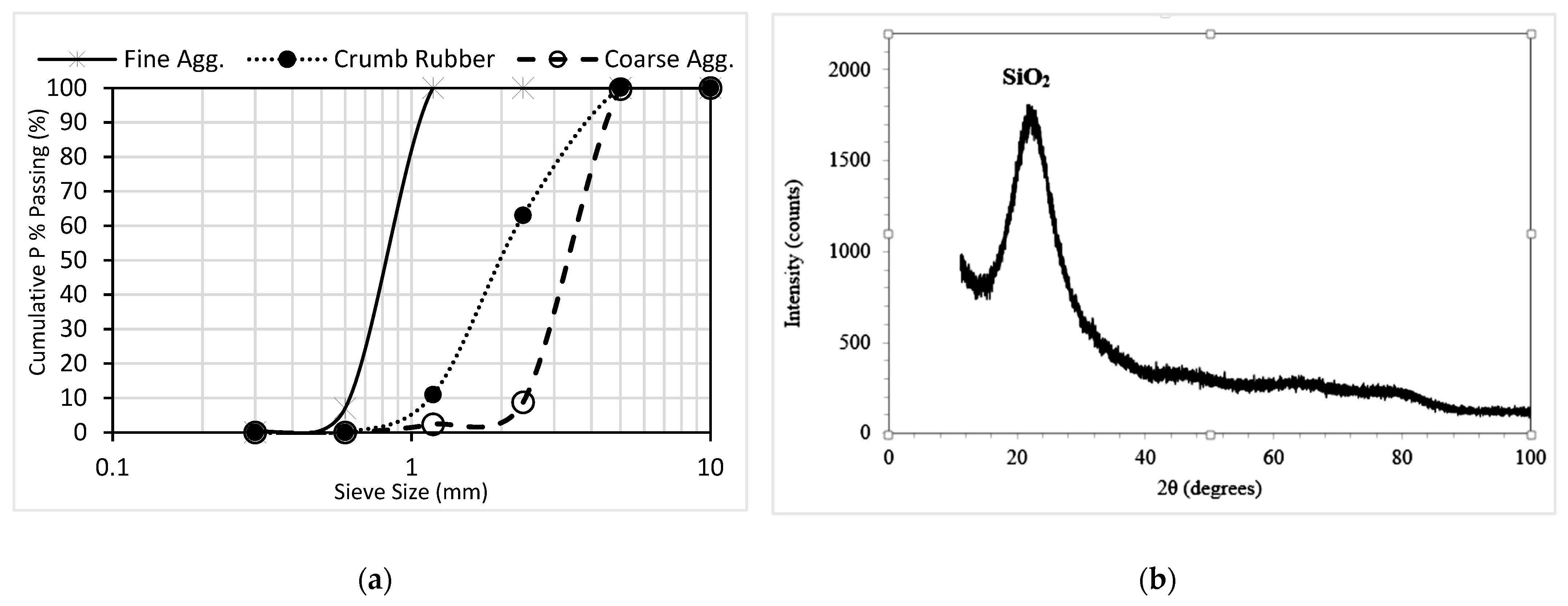
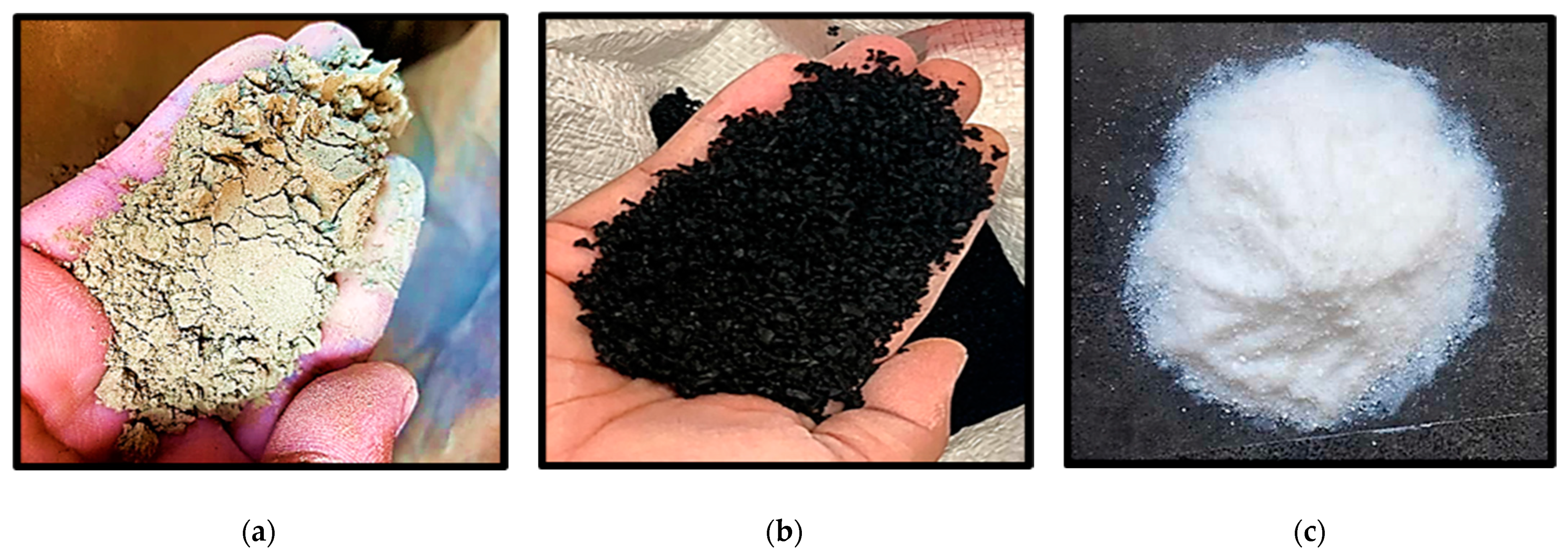
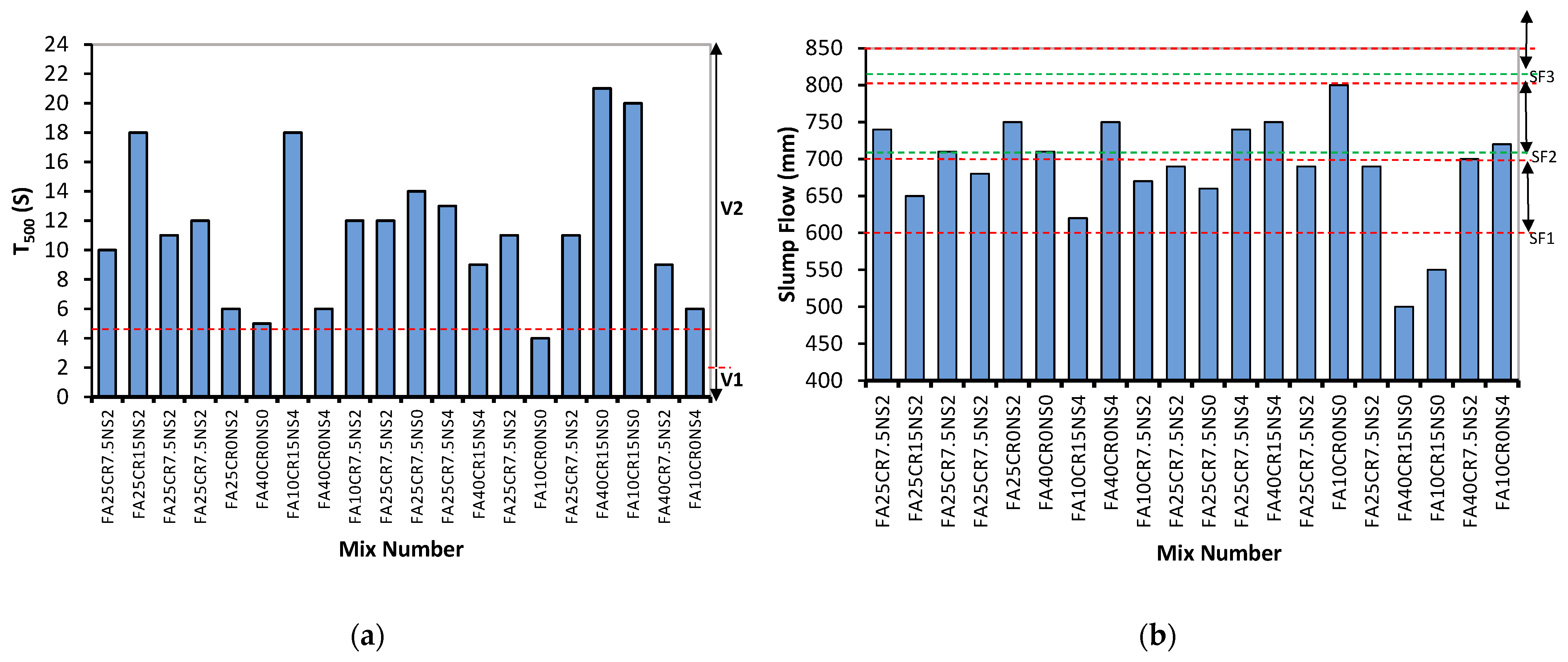
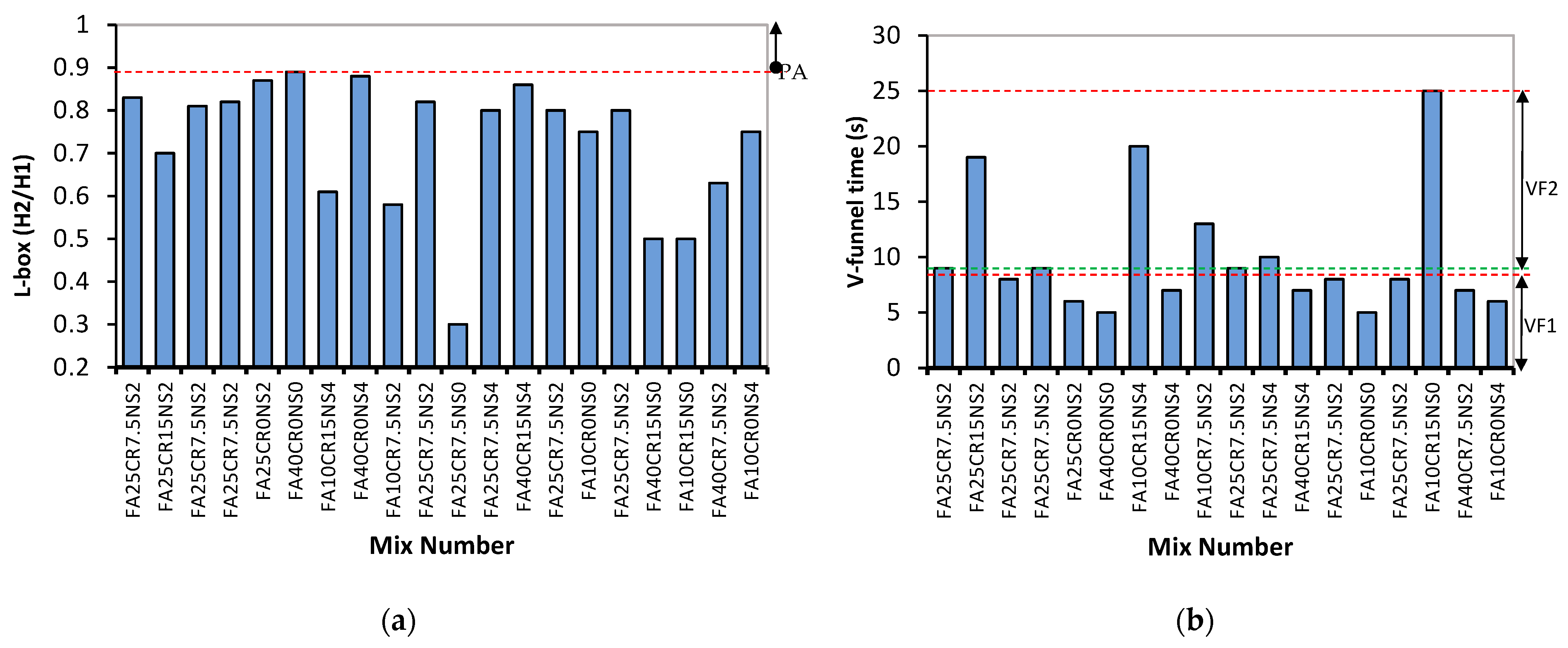
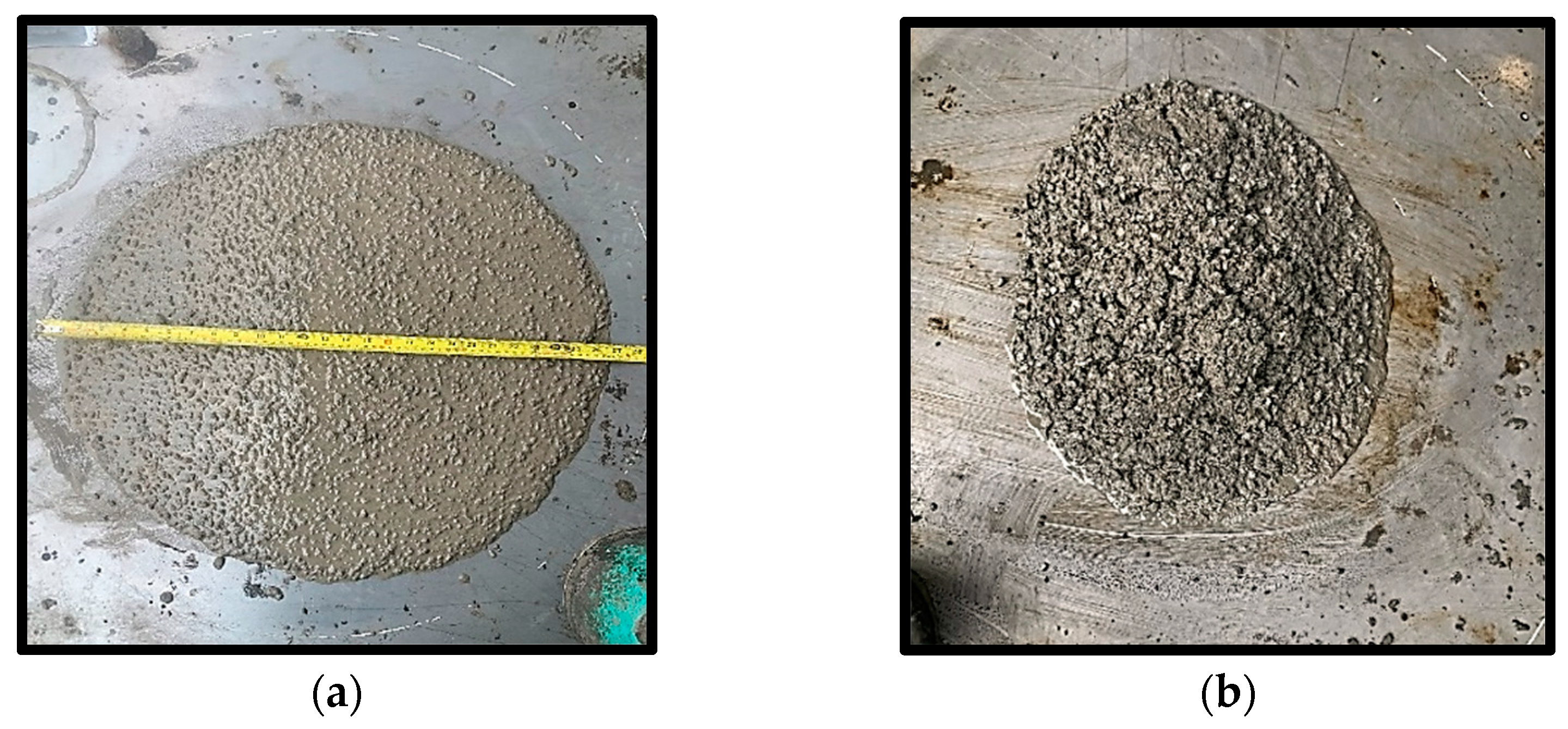

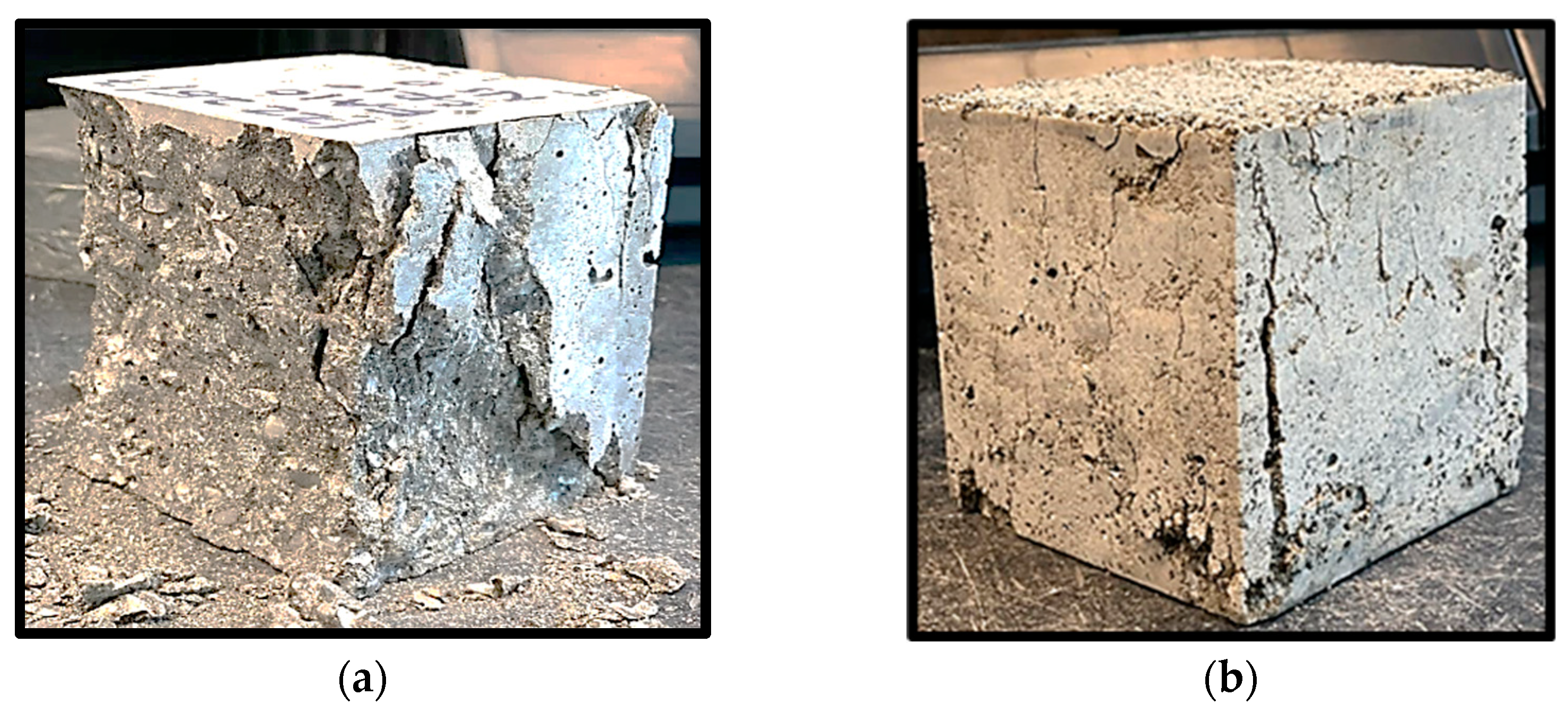
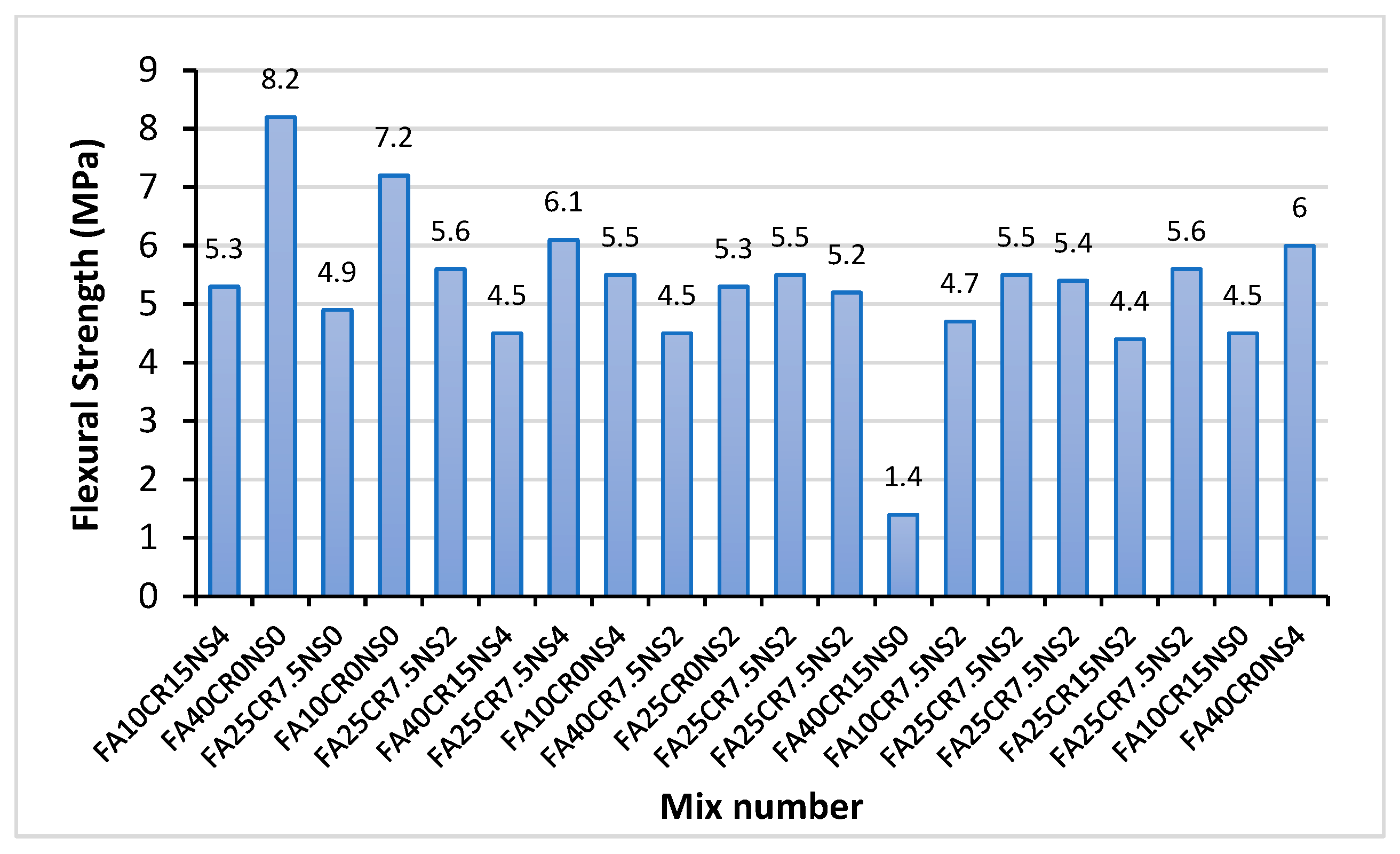
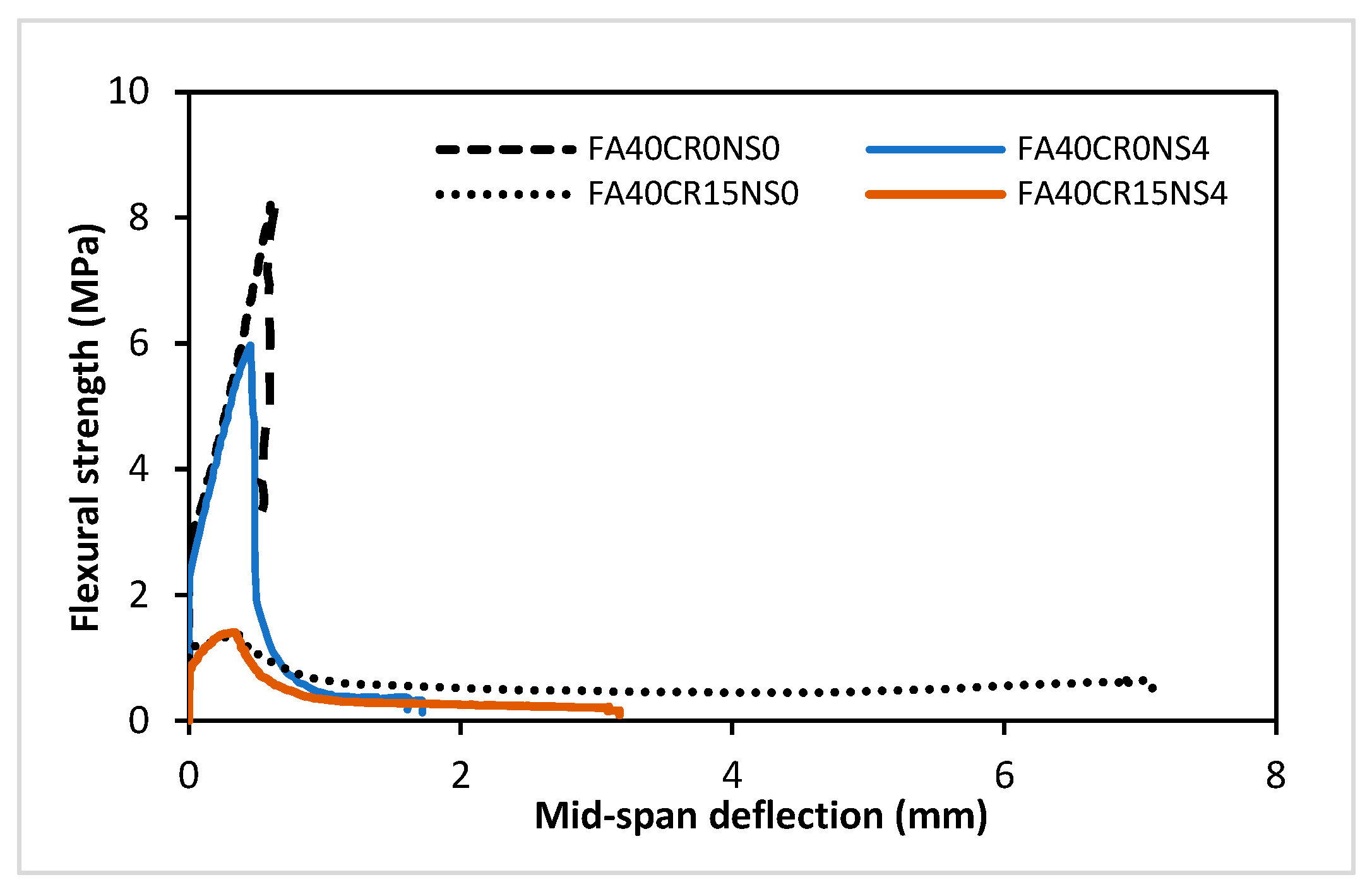
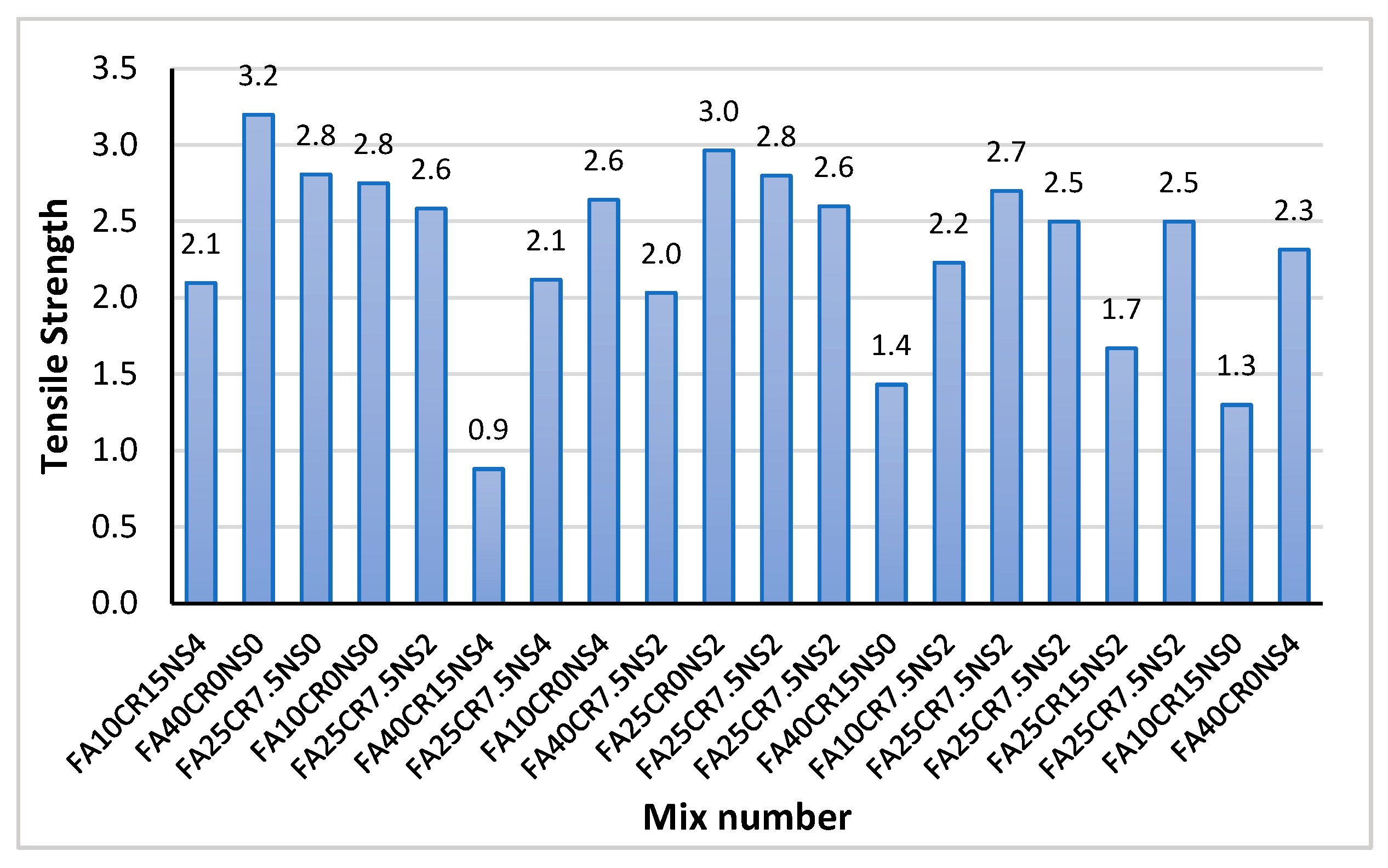



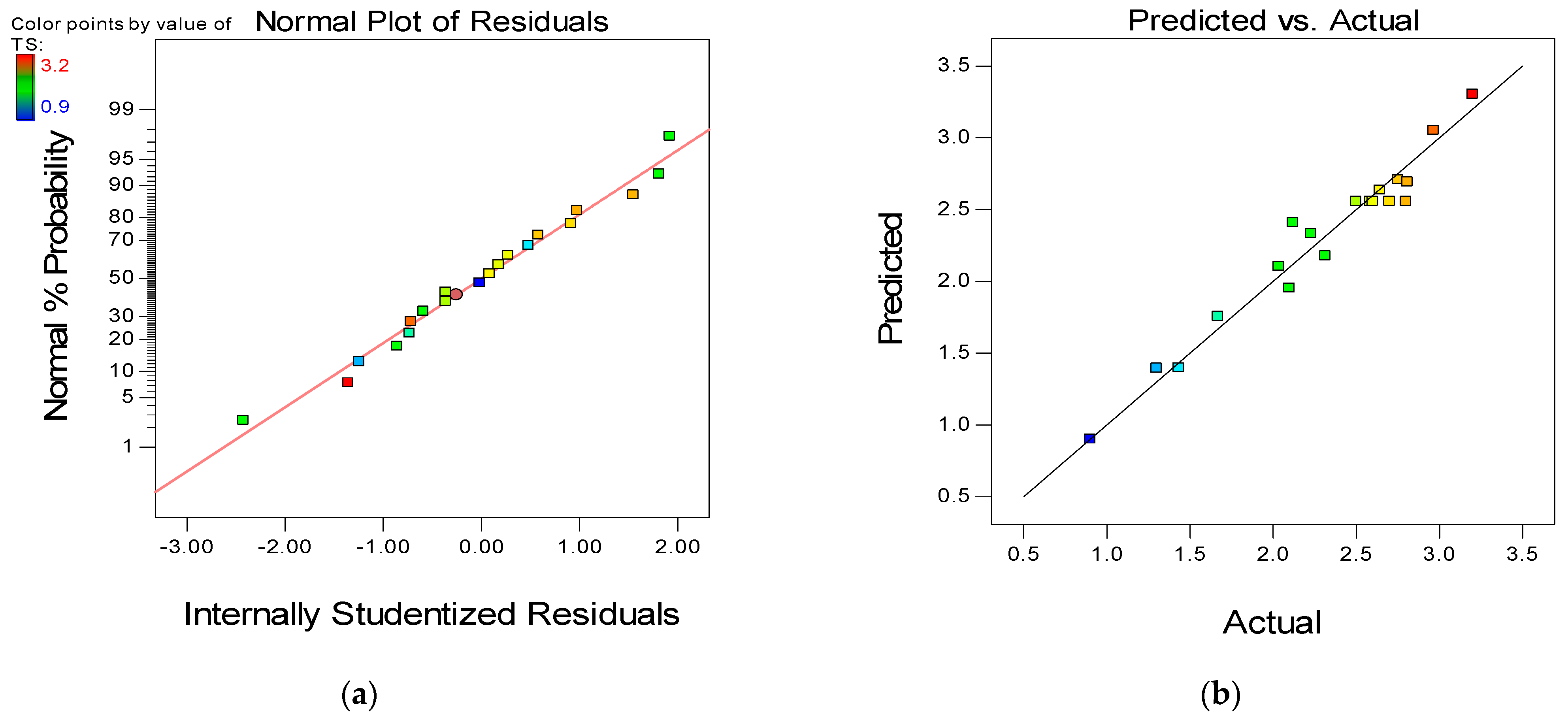
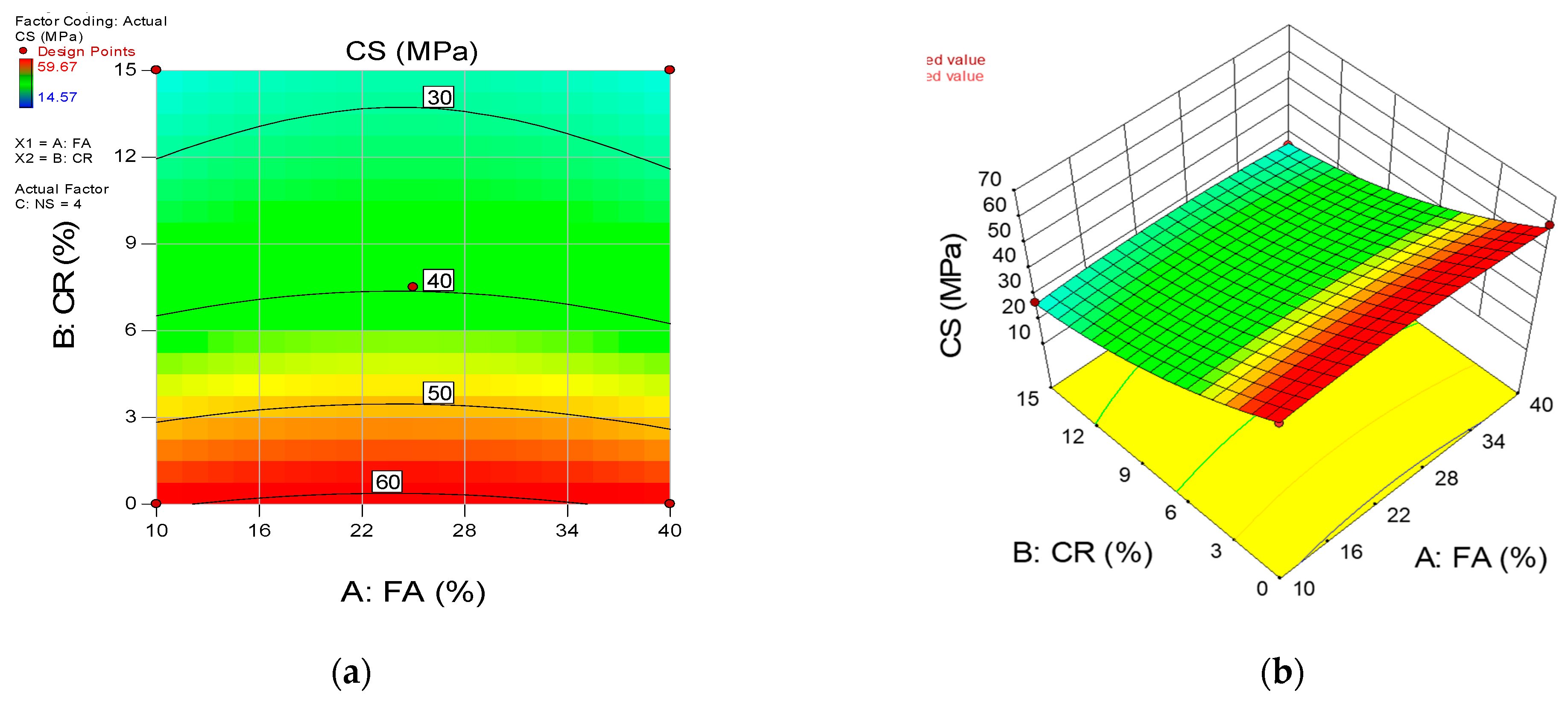
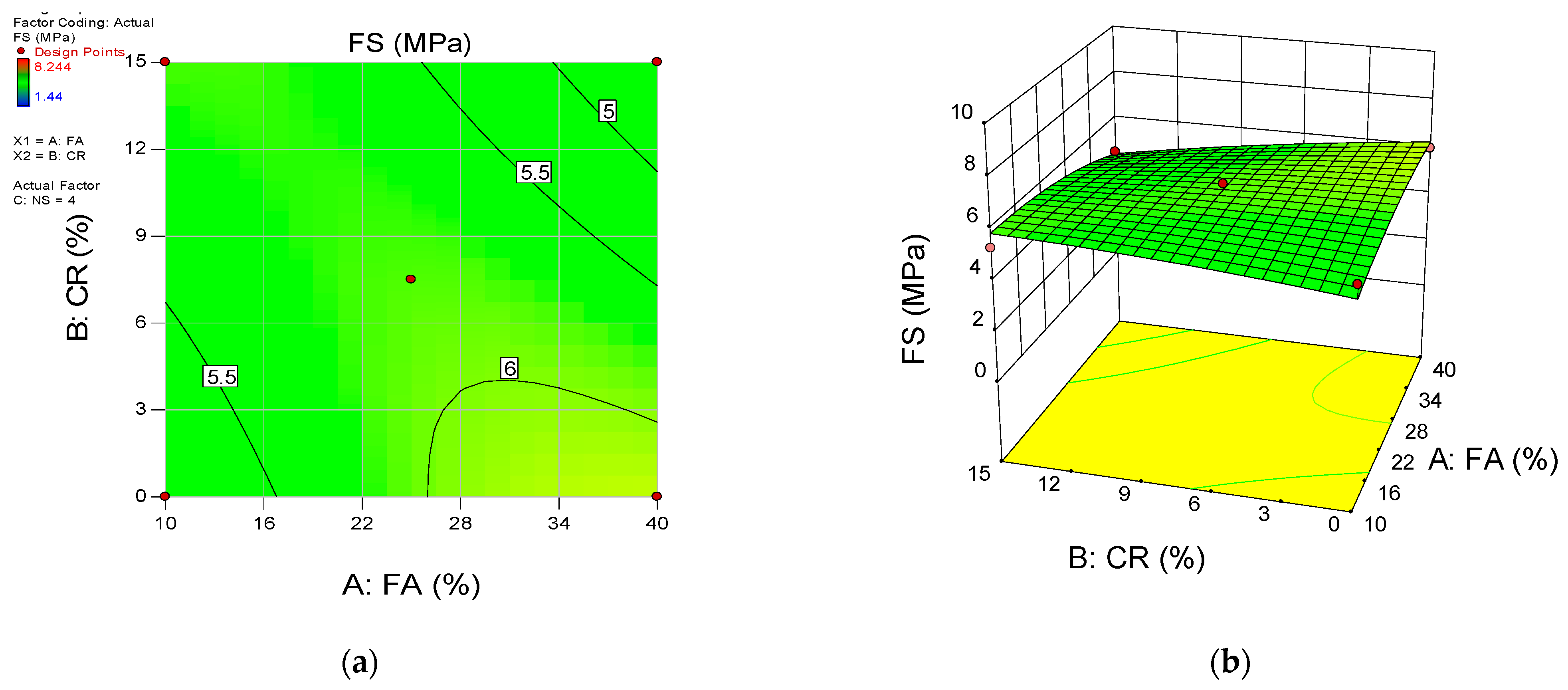
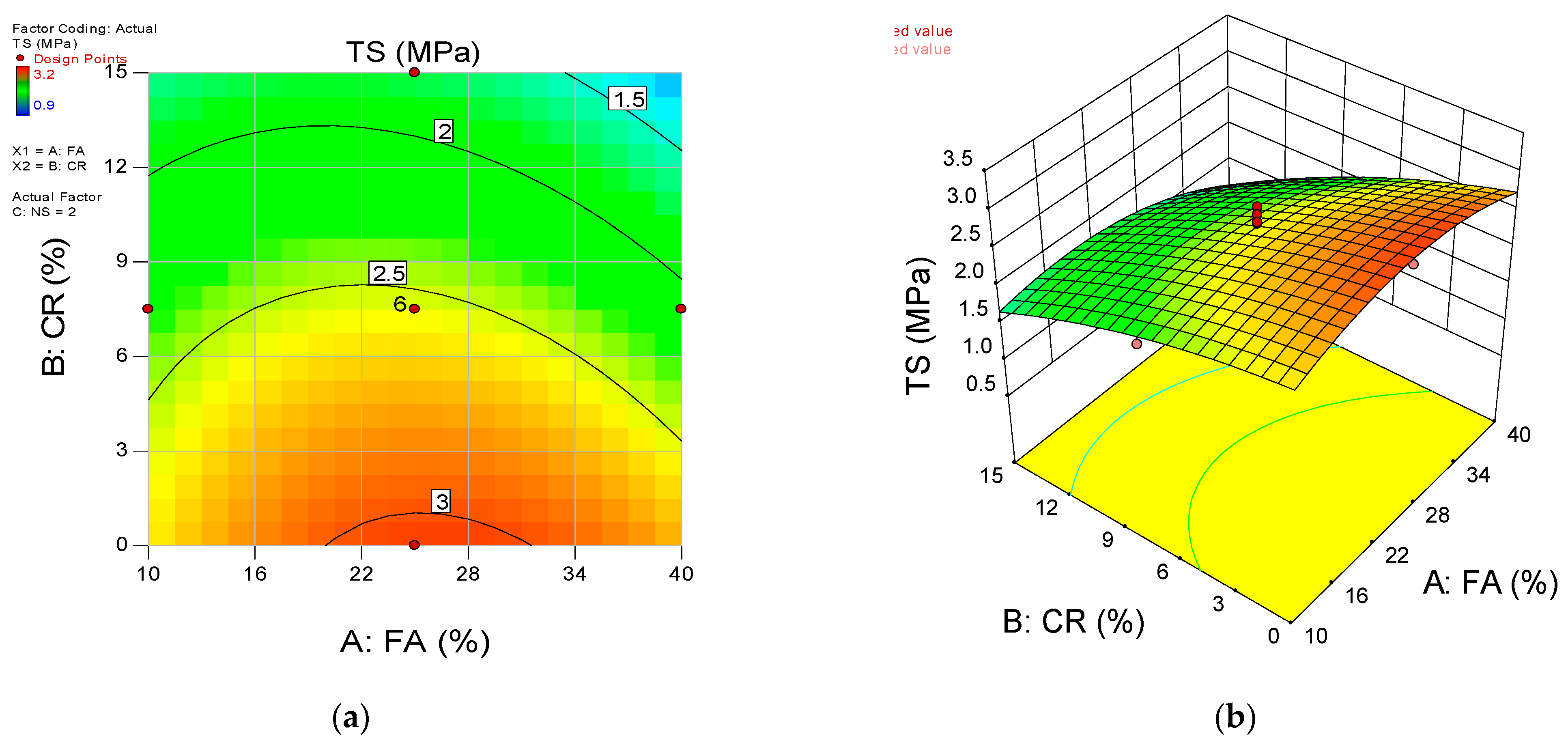
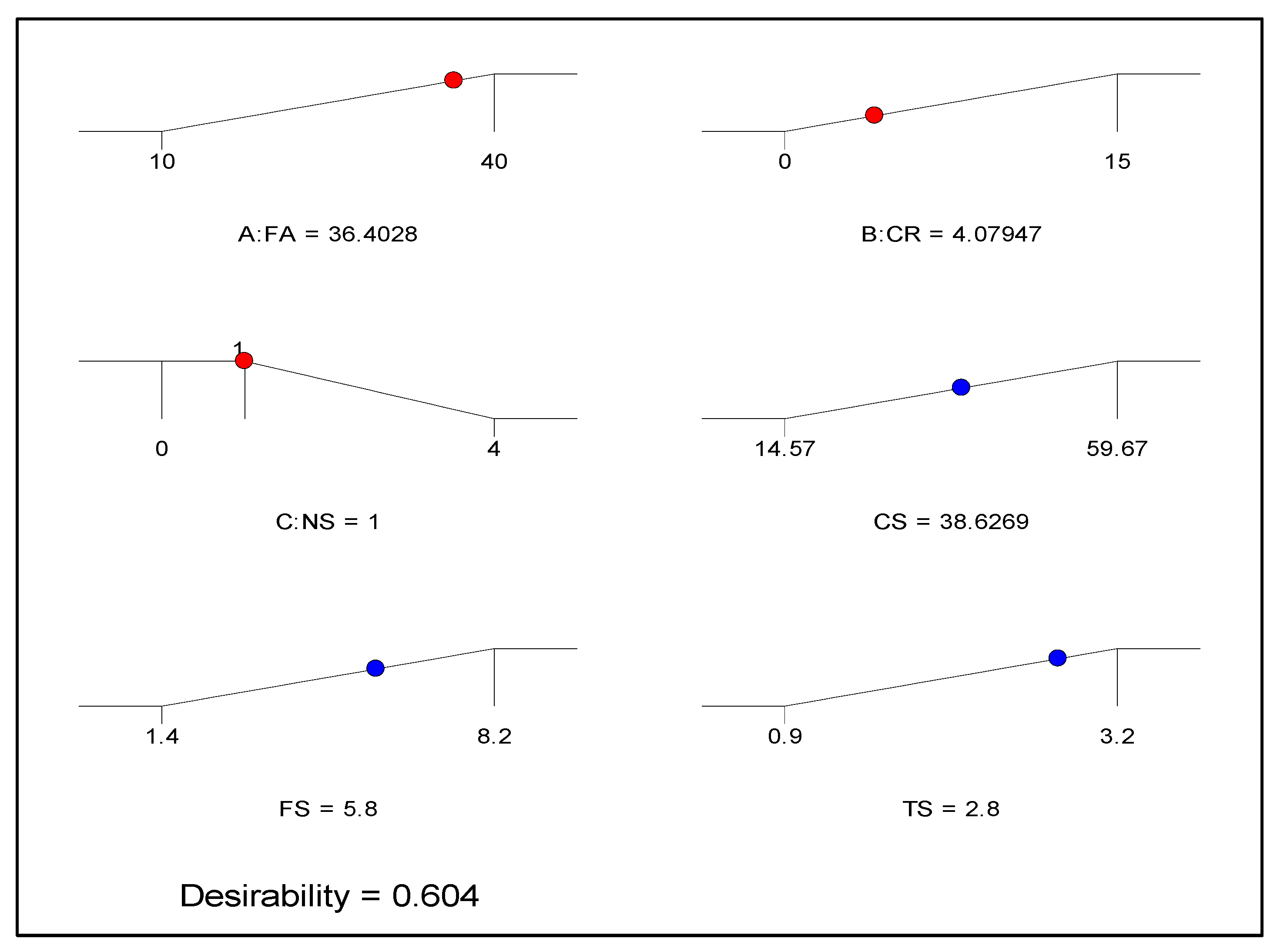
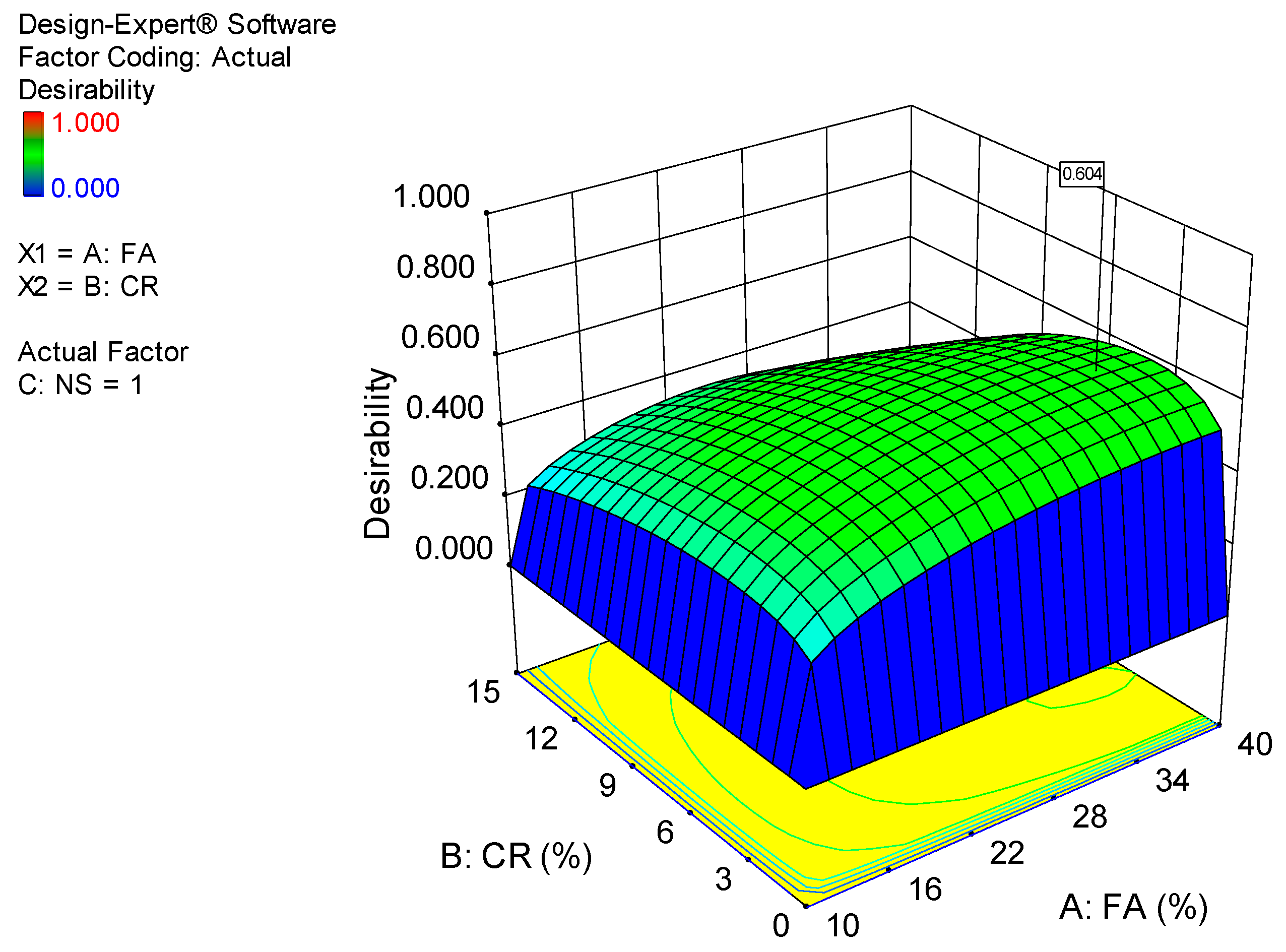
| Physical Properties | Fine Aggregates | Coarse Aggregates | Crumb Rubber |
|---|---|---|---|
| Specific Gravity | 2.65 | 2.61 | 0.95 |
| Water Absorption (%) | 2.10 | 1.17 | - |
| Moisture Content (%) | 1.3 | - | - |
| Fineness Modulus | 2.20 | 6.127 | 0.92 |
| Oxide | CaO | SiO2 | Fe2O3 | Al2O3 | K2O | MgO | SO3 | Na2O |
|---|---|---|---|---|---|---|---|---|
| OPC | 64.64 | 21.28 | 3.36 | 5.60 | 1.68 | 2.06 | 2.14 | 0.98 |
| FA | 5.98 | 64.69 | 4.90 | 18.89 | 1.14 | 1.99 | 0.10 | 2.41 |
| Mix Reference | Cementitious Material | Aggregates | Water kg/m3 | |||||||
|---|---|---|---|---|---|---|---|---|---|---|
| OPC kg/m3 | FA | NS | Fine Agg. | CR | Coarse Agg. | |||||
| % | kg/m3 | % | kg | kg/m3 | % | kg/m3 | kg/m3 | |||
| FA10CR0NS4 | 540.00 | 10 | 60.00 | 4 | 0.02 | 882.00 | 0 | 0.00 | 588.00 | 210.00 |
| FA10CR15NS0 | 540.00 | 10 | 60.00 | 0 | 0.00 | 749.70 | 15 | 132.30 | 588.00 | 210.00 |
| FA10CR7.5NS2 | 540.00 | 10 | 60.00 | 2 | 0.01 | 815.85 | 7.5 | 66.15 | 588.00 | 210.00 |
| FA10CR0NS0 | 540.00 | 10 | 60.00 | 0 | 0.00 | 882.00 | 0 | 0.00 | 588.00 | 210.00 |
| FA10CR15NS4 | 540.00 | 10 | 60.00 | 4 | 0.02 | 749.70 | 15 | 132.30 | 588.00 | 210.00 |
| FA25CR7.5NS2 | 450.00 | 25 | 150.00 | 2 | 0.01 | 815.85 | 7.5 | 66.15 | 588.00 | 210.00 |
| FA25CR0NS2 | 450.00 | 25 | 150.00 | 2 | 0.01 | 882.00 | 0 | 0.00 | 588.00 | 210.00 |
| FA25CR7.5NS2 | 450.00 | 25 | 150.00 | 2 | 0.13 | 815.85 | 7.5 | 66.15 | 588.00 | 210.00 |
| FA25CR7.5NS4 | 450.00 | 25 | 150.00 | 4 | 0.02 | 815.85 | 7.5 | 66.15 | 588.00 | 210.00 |
| FA25CR15NS2 | 450.00 | 25 | 150.00 | 2 | 0.01 | 749.70 | 15 | 132.30 | 588.00 | 210.00 |
| FA25CR7.5NS2 | 450.00 | 25 | 150.00 | 2 | 0.01 | 815.85 | 7.5 | 66.15 | 588.00 | 210.00 |
| FA25CR7.5NS0 | 450.00 | 25 | 150.00 | 0 | 0.00 | 815.85 | 7.5 | 66.15 | 588.00 | 210.00 |
| FA25CR7.5NS2 | 450.00 | 25 | 150.00 | 2 | 0.01 | 815.85 | 7.5 | 66.15 | 588.00 | 210.00 |
| FA25CR7.5NS2 | 450.00 | 25 | 150.00 | 2 | 0.01 | 815.85 | 7.5 | 66.15 | 588.00 | 210.00 |
| FA25CR7.5NS2 | 450.00 | 25 | 150.00 | 2 | 0.01 | 815.85 | 7.5 | 66.15 | 588.00 | 210.00 |
| FA40CR0NS4 | 360.00 | 40 | 240.00 | 4 | 0.02 | 882.00 | 0 | 0.00 | 588.00 | 210.00 |
| FA40CR0NS0 | 360.00 | 40 | 240.00 | 0 | 0.00 | 882.00 | 0 | 0.00 | 588.00 | 210.00 |
| FA40CR7.5NS2 | 360.00 | 40 | 240.00 | 2 | 0.01 | 815.85 | 7.5 | 66.15 | 588.00 | 210.00 |
| FA40CR15NS0 | 360.00 | 40 | 240.00 | 0 | 0.00 | 749.70 | 15 | 132.30 | 588.00 | 210.00 |
| FA40CR15NS4 | 360.00 | 40 | 240.00 | 4 | 0.02 | 749.70 | 15 | 132.30 | 588.00 | 210.00 |
| Response | Source | Sum of Squares | Df | Mean Square | F-Value | p-Value > F | Significance |
|---|---|---|---|---|---|---|---|
| Compressive strength (MPa) | Model | 3724.12 | 9 | 413.79 | 90.06 | <0.0001 | Yes |
| A-FA | 10.73 | 1 | 10.73 | 2.34 | 0.1574 | No | |
| B-CR | 3296.4 | 1 | 3296.4 | 717.46 | <0.0001 | Yes | |
| C-NS | 153.98 | 1 | 153.98 | 33.51 | 0.0002 | Yes | |
| AB | 0.088 | 1 | 0.088 | 0.019 | 0.8926 | No | |
| AC | 4.26 | 1 | 4.26 | 0.93 | 0.3581 | No | |
| BC | 30.73 | 1 | 30.73 | 6.69 | 0.0271 | Yes | |
| A2 | 13.88 | 1 | 13.88 | 3.02 | 0.1129 | No | |
| B2 | 80.89 | 1 | 80.89 | 17.61 | 0.0018 | Yes | |
| C2 | 33.95 | 1 | 33.95 | 7.39 | 0.0216 | Yes | |
| Residual | 4.02 | 10 | 0.4 | ||||
| Lack of Fit | 45.35 | 5 | 9.07 | 75.65 | 0.0001 | Yes | |
| Pure Error | 0.6 | 5 | 0.12 | ||||
| Cor Total | 3770.06 | 19 | |||||
| Flexural strength (MPa) | Model | 27.58 | 9 | 3.06 | 7.63 | 0.0019 | Yes |
| A-FA | 0.66 | 1 | 0.66 | 1.64 | 0.2287 | No | |
| B-CR | 14.29 | 1 | 14.29 | 35.55 | 0.0001 | Yes | |
| C-NS | 0.11 | 1 | 0.11 | 0.28 | 0.6066 | No | |
| AB | 3.64 | 1 | 3.64 | 9.07 | 0.0131 | Yes | |
| AC | 0.39 | 1 | 0.39 | 0.96 | 0.3503 | No | |
| BC | 7.7 | 1 | 7.7 | 19.16 | 0.0014 | Yes | |
| A2 | 0.37 | 1 | 0.37 | 0.92 | 0.3603 | No | |
| B2 | 0.048 | 1 | 0.048 | 0.12 | 0.7361 | No | |
| C2 | 0.67 | 1 | 0.67 | 1.67 | 0.2254 | No | |
| Residual | 4.02 | 10 | 0.4 | ||||
| Lack of Fit | 3.91 | 5 | 0.78 | 36.09 | 0.0006 | Yes | |
| Pure Error | 0.11 | 5 | 0.022 | ||||
| Cor Total | 31.6 | 19 | |||||
| Tensile strength (MPa) | Model | 6.47 | 9 | 0.72 | 25.79 | <0.0001 | Yes |
| A-FA | 0.13 | 1 | 0.13 | 4.66 | 0.0562 | No | |
| B-CR | 4.19 | 1 | 4.19 | 150.24 | <0.0001 | Yes | |
| C-NS | 0.2 | 1 | 0.2 | 7.21 | 0.0229 | Yes | |
| AB | 0.18 | 1 | 0.18 | 6.31 | 0.0308 | Yes | |
| AC | 0.56 | 1 | 0.56 | 19.92 | 0.0012 | Yes | |
| BC | 0.2 | 1 | 0.2 | 7.12 | 0.0236 | Yes | |
| A2 | 0.32 | 1 | 0.32 | 11.31 | 0.0072 | Yes | |
| B2 | 0.065 | 1 | 0.065 | 2.32 | 0.1588 | No | |
| C2 | 1.09 × 10−4 | 1 | 1.09 × 10−4 | 3.92 × 10−3 | 0.9513 | No | |
| Residual | 0.28 | 10 | 0.028 | ||||
| Lack of Fit | 0.21 | 5 | 0.042 | 3.04 | 0.124 | No | |
| Pure Error | 0.069 | 5 | 0.014 | ||||
| Cor Total | 6.75 | 19 |
| Model Validation Parameters | CS | FS | TS |
|---|---|---|---|
| Std. Dev. | 2.14 | 0.63 | 0.17 |
| Mean | 35.60 | 5.28 | 2.31 |
| C.V. % | 6.02 | 12.02 | 7.24 |
| PRESS | 295.93 | 43.98 | 2.08 |
| −2 Log Likelihood | 73.39 | 24.66 | −28.70 |
| R-Squared | 0.99 | 0.87 | 0.96 |
| Adj R-Squared | 0.98 | 0.76 | 0.92 |
| Pred R-Squared | 0.92 | −0.39 | 0.69 |
| Adeq Precision | 30.50 | 12.72 | 20.34 |
| BIC | 103.35 | 54.62 | 1.26 |
| AICc | 117.84 | 69.10 | 15.74 |
| Factors | Input Factors | Responses (Output Factors) | |||||
|---|---|---|---|---|---|---|---|
| FA (%) | CR (%) | NS (%) | CS (MPa) | FS (MPa) | TS (MPa) | ||
| Value | Minimum | 10 | 0 | 0 | 14.57 | 1.4 | 0.9 |
| Maximum | 40 | 15 | 4 | 59.67 | 8.2 | 3.2 | |
| Goal | Maximize | Maximize | Minimize | Maximize | Maximize | Maximize | |
| Optimization result | 36.38 | 4.08 | 1.00 | 38.63 | 5.80 | 2.80 | |
| Desirability | 0.604 (60%) | ||||||
| Response | Predicted | Experimental | Error (%) |
|---|---|---|---|
| CS (MPa) | 38.63 | 40.10 | 3.8 |
| FS (MPa) | 5.80 | 5.58 | 3.9 |
| TS (MPa) | 2.80 | 2.92 | 4.2 |
Publisher’s Note: MDPI stays neutral with regard to jurisdictional claims in published maps and institutional affiliations. |
© 2022 by the authors. Licensee MDPI, Basel, Switzerland. This article is an open access article distributed under the terms and conditions of the Creative Commons Attribution (CC BY) license (https://creativecommons.org/licenses/by/4.0/).
Share and Cite
Rahim, N.I.; Mohammed, B.S.; Abdulkadir, I.; Dahim, M. Effect of Crumb Rubber, Fly Ash, and Nanosilica on the Properties of Self-Compacting Concrete Using Response Surface Methodology. Materials 2022, 15, 1501. https://doi.org/10.3390/ma15041501
Rahim NI, Mohammed BS, Abdulkadir I, Dahim M. Effect of Crumb Rubber, Fly Ash, and Nanosilica on the Properties of Self-Compacting Concrete Using Response Surface Methodology. Materials. 2022; 15(4):1501. https://doi.org/10.3390/ma15041501
Chicago/Turabian StyleRahim, Nurul Izzati, Bashar S. Mohammed, Isyaka Abdulkadir, and Mohammed Dahim. 2022. "Effect of Crumb Rubber, Fly Ash, and Nanosilica on the Properties of Self-Compacting Concrete Using Response Surface Methodology" Materials 15, no. 4: 1501. https://doi.org/10.3390/ma15041501






